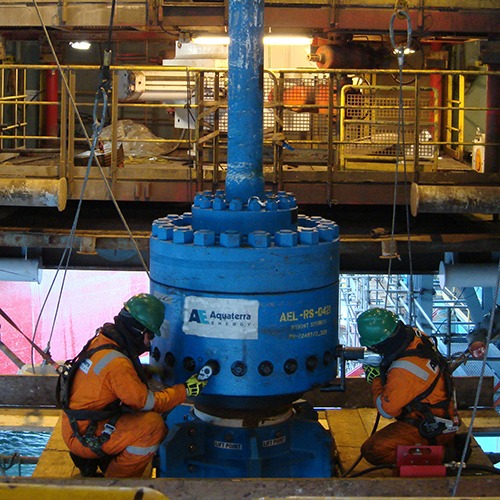
Choosing the Right Connector Package: 5 Key Considerations
Offshore conditions are some of the most hazardous in the world. It’s why you need to ensure that a riser system, between the BOP and wellhead, is robust, structurally secure, and pressure-containing.
There are many things to consider when selecting a drilling adaptor or riser system connector package for your project. As well as your supplier, you need to assess the reliability and lead-time of the product itself, plus the levels of risk and cost.
Being all too familiar with these risks and considerations and wanting to help operators and rig owners, we designed our own range of connector products and packages. The Aquaterra Quick Connect (AQC) is focused on well control equipment, such as riser systems and BOP connectors between the rig’s BOP and wellhead.
With so many options on the market, here are our five considerations to bear in mind when selecting your next connector package:
1. Compatibility
Consideration has to be given to what is in place already. Will your new connector package work with existing infrastructure, or not?
This was also a consideration when designing our AQC. Designed to replace a standard API flange connector, it’s compatible with existing proprietary wellhead profiles and drilling adapters. We wanted to ensure that it could be used either in part or in its entirety and therefore we eliminated any interfacing concerns our customers might have when combining it with any existing infrastructure that might be on board the rig already. For instance, the AQC can be used as part of the surface riser system, interfacing between the upper joint and a jack-up’s existing connector on the bottom of the drilling BOP.
2. Time
Let’s talk time, specifically rig time. It’s a well-known fact in the industry that the make-up process for flanged connectors is very time-consuming. Some of the biggest advantages of using a super-fast connector package, such as the AQC, over a traditional flanged connector is reduced make-up times.
The large amount of time needed to install a flanged connector is due largely to the number of intricate parts that need to be torque loaded in place. A typical 18 ¾” 15k BOP API flange connection has 20 studs and 40 nuts which all have to be manually fixed onto the connector by hand and then individually hydraulically tightened. In comparison to a standard API flange or hub connection of the same size and pressure class, the method and time to make up the AQC connection can vary considerably. For instance, the make-up or break-out of a standard 18 ¾” 15k API flange can take around five hours of rig time, but the AQC takes a fraction of the time at around 15 minutes and less than five minutes for a hydraulic option.
3. Cost
Time costs money and when something takes a long time, it’s going to increase your CapEx and OpEx. If using an API flanged connector package, you need to be aware of your costs as the five hours of rig time per connector will soon add up.
To show that as a cost-saving example, if the spread rate for the rig was $300,000 per day, then that is equal to $12,500 per hour. Using a flanged connector can cost around $62,500 of rig time to install. Installation of the AQC would cost just $3,125 of rig time.
4. Safety
Anything to reduce risk and increase safety should be done wherever possible; safety is paramount, and therefore this has to be another consideration when selecting your connector package.
The online make-up of flanged connectors and the manual tightening of 20 studs and 40 nuts also bring increased safety risks and challenges. Dynamic loading can further complicate the problems associated with API flanges, by causing safety risks such as the loosening of studs and nuts and leaking gaskets. Other safety considerations can include dropped objects and hand injuries during the torque make-up process – to name just a few.
5. Lead-time
In terms of lead-times, some proprietary wellhead profiles and drilling adapter suppliers on the market can take up to a year for delivery. This is mainly due to the availability of materials and some manufacturer’s project and supplier management processes.
We boast a streamlined project and supply chain offering which keeps a stock of materials that meet the latest API 16A specification requirements. This enables us to provide an essential range of in-demand, readily available products and solutions that meet the demands of customers globally as part of our Aquaterra Express rental tools and equipment service. AQC products and packages can be sourced and delivered quickly and offer a 75% reduction in delivery lead-time and up to two-thirds lower on capital expenditure. And although it is a standard, on-demand product, it can also be designed and customised to fit different riser system applications if needed.
The final word
It’s a well-accepted norm in our industry that API flanges are time-consuming to make-up and have some inherent undesirable features; such as multiple loose parts, heavy and cumbersome make-up equipment and typically perform poorly under dynamic loading (pressure, bending and tension).
Quick Connectors are generally designed to outperform their corresponding API flange size and pressure class in dynamic loading situations and importantly, contain no loose parts. This greatly enhances the functional performance of the connector and will improve operator safety due to a reduction in manual handling and lower torque make-up requirements.
With a quick connector, you not only benefit from all of the safety and operational benefits but there is also significant time and cost savings to be gained over your campaign that could lead to many rig-days saved.
If you want to know more about quick connector packages, or further support in understanding considerations for your specific project, get in touch.